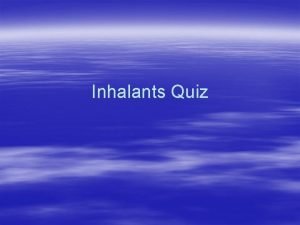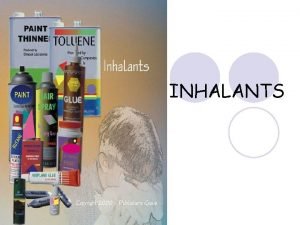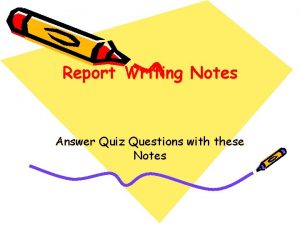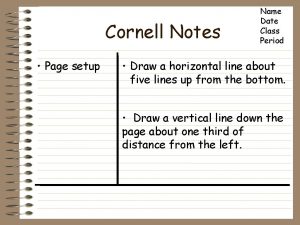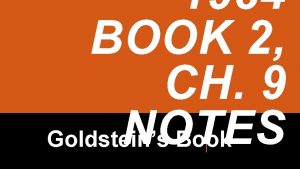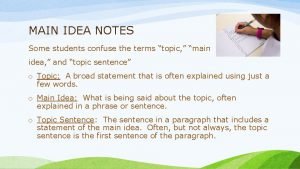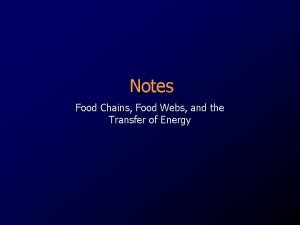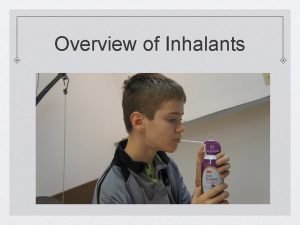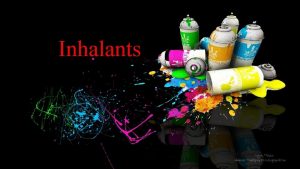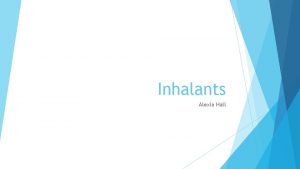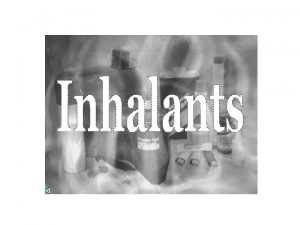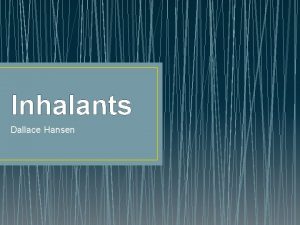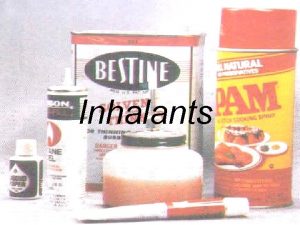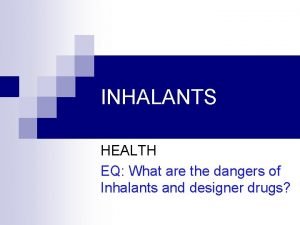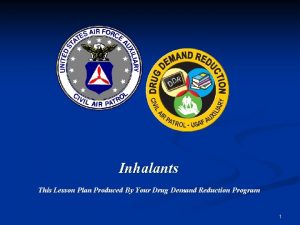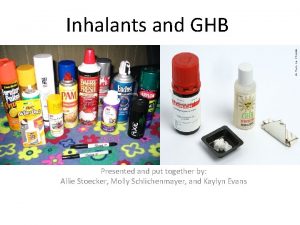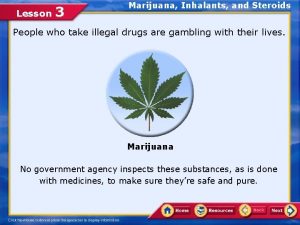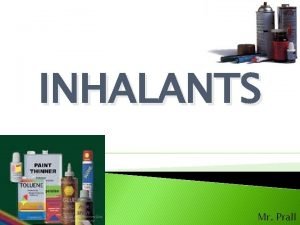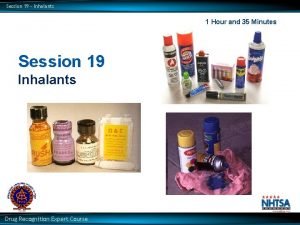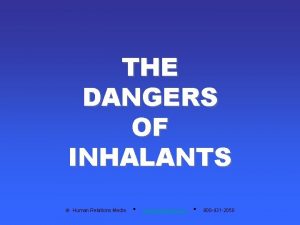NOTES ON INHALANTS Inhalants 1 2 Inhalants are


















- Slides: 18

NOTES ON INHALANTS

Inhalants 1. 2. Inhalants are substances that produce chemical vapors that can be inhaled to produce a psychoactive, or mind-altering effect. The term inhalants is used to describe a variety of substances whose common characteristic is that they are rarely taken by any other route other than inhalation.

Inhalants 3. 4. Inhalants are a broad range of chemicals found in different products that may have different pharmacological effects. There are 4 main classifications of inhalants: Volatile solvents Gases Aerosols Nitrites

Inhalants 5. 6. Inhalants are found in household, industrial, and medical products. Volatile solvents: These are liquids that vaporize at room temperature They are found in a multitude of inexpensive, easily attainable products

Inhalants 7. Examples of volatile solvents: Paint thinners and removers Dry-cleaning fluids Degreasers Gasoline Glues Felt-tip markers Correction fluid (white out) Nail polish remover Freon

Inhalants 8. 9. Aerosols are sprays that contain propellants and solvents. Examples of aerosols: Spray paint Deodorant Hair spray Vegetable oil Fabric spray

Inhalants 10. Gases: Include medical anesthetics as well as gases used in household or commercial products. Can cause bone marrow damage

Inhalants 11. Medical anesthetics include: Chloroform Halothane Laughing gas Of these, laughing gas is the most abused.

Inhalants 12. 13. Household or commercial products include: Gases in butane lighters Propane tanks Refrigerant (Freon) Inhalants are often the first drug abused by young children. National surveys indicate that about 3% of U. S. children have tried inhalants by the 4 th grade.

Inhalants 14. Nitrites: Often considered a special class of inhalants Unlike most other inhalants which affect the central nervous system, nitrites act on blood vessels and relax muscles 15. More 8 th graders have tried inhalants than any other drug, including marijuana

Inhalants 16. Short-term effects of inhalants: Belligerence Apathy Impaired judgment Dizziness Drowsiness Slurred speech Depressed reflexes Stupor Nausea Vomiting

Inhalants 17. Long-term effects of inhalants: Compulsive use Mild withdraw syndrome Weight loss Muscle weakness Disorientation Inattentiveness Lack of coordination Irritability Depression

Medical consequences of inhalant abuse that can cause death: 18. “Sudden sniffing death” - Prolonged sniffing of chemicals can cause irregular heart rhythms and could lead to heart failure and death within minutes of a session of prolonged sniffing. 19. Asphyxiation – occurs from repeated inhalations which leads to high concentrations of inhaled fumes displacing oxygen in the lungs

Medical consequences of inhalant abuse that can cause death 20. Suffocation – results from blocking air from entering the lungs when inhaling fumes from a plastic bag placed over the head 21. Convulsions or seizures – caused by abnormal electrical discharges in the brain.

Medical consequences of inhalant abuse that can cause death 22. 23. Coma – the brain shuts down all but the most vital functions Choking – results from inhalation of vomit after inhalant use 24. Fatal injury – results from accidents in motor vehicles suffered from being intoxicated

Inhalants vocabulary: 25. 26. 27. Huffed : inhalant-soaked rag, sock, or roll of toilet paper in mouth Anesthetic : an agent that removes the ability to feel pain Toxic : causing temporary or permanent effects that are detrimental to the functioning of body organs

Inhalants vocabulary: 28. 29. 30. Benzene : Bone marrow injury, impaired function, increased likelihood of getting leukemia Butane : sudden sniffing death syndrome via cardiac effects Rush : a surge of pleasure that rapidly follows administration of drug

Inhalants vocabulary 31. Relapse – to fall back into a former state.
 Mikael ferm
Mikael ferm Most inhalants are actually intended to be _______________
Most inhalants are actually intended to be _______________ Inhalants history
Inhalants history Conversion notes brutes en notes standard wisc 5
Conversion notes brutes en notes standard wisc 5 Report writing quiz answer key
Report writing quiz answer key Cornell notes setup
Cornell notes setup Pharmaceutical biotechnology notes
Pharmaceutical biotechnology notes Operation theatre notes
Operation theatre notes Goldsteins experiment
Goldsteins experiment Image processing lecture notes
Image processing lecture notes Slide todoc.com
Slide todoc.com Simple discount example
Simple discount example Main idea notes
Main idea notes Foster claire keegan
Foster claire keegan 5 themes of geography notes
5 themes of geography notes Bookspar
Bookspar Present progressive notes
Present progressive notes Geography paper 2 revision notes
Geography paper 2 revision notes Food web notes
Food web notes

